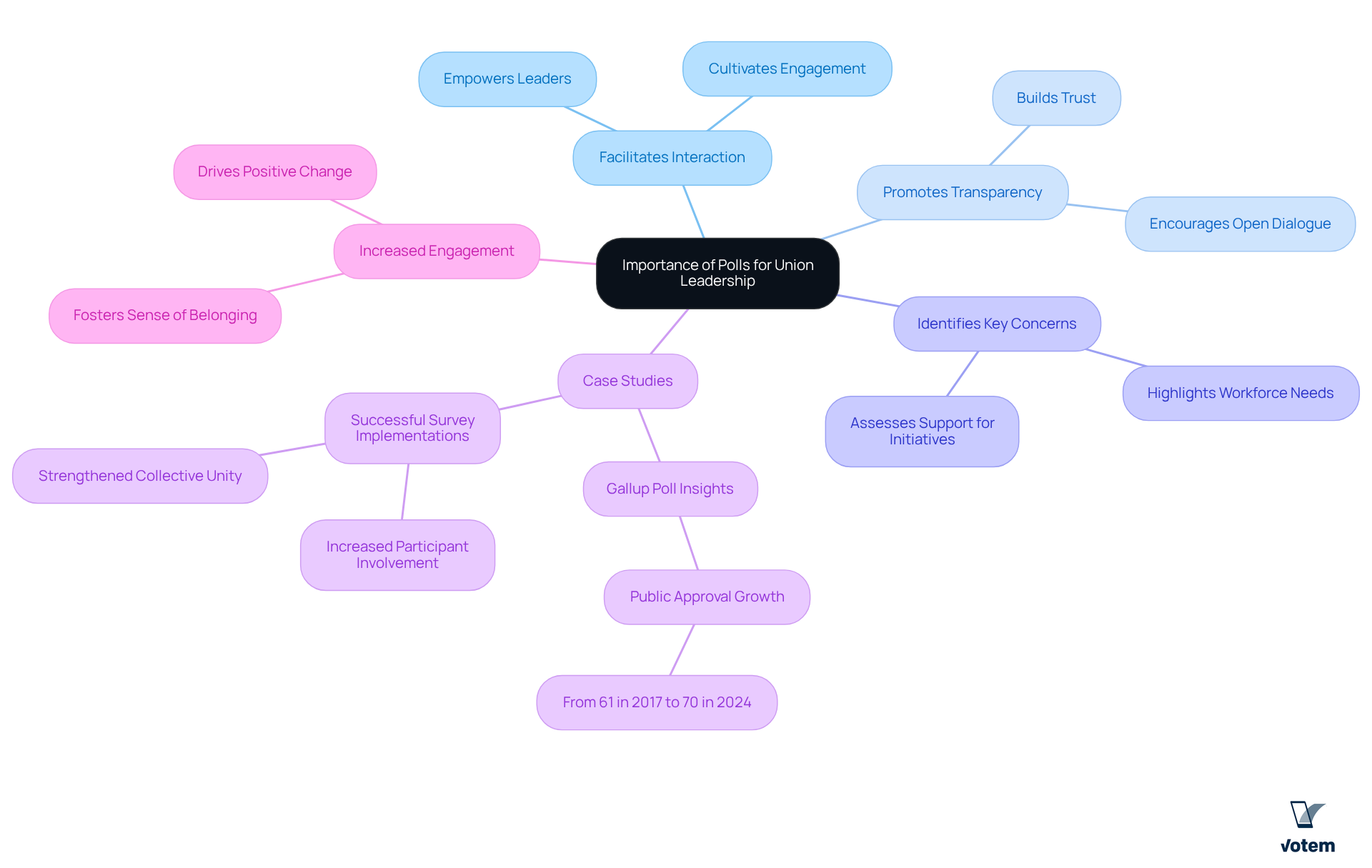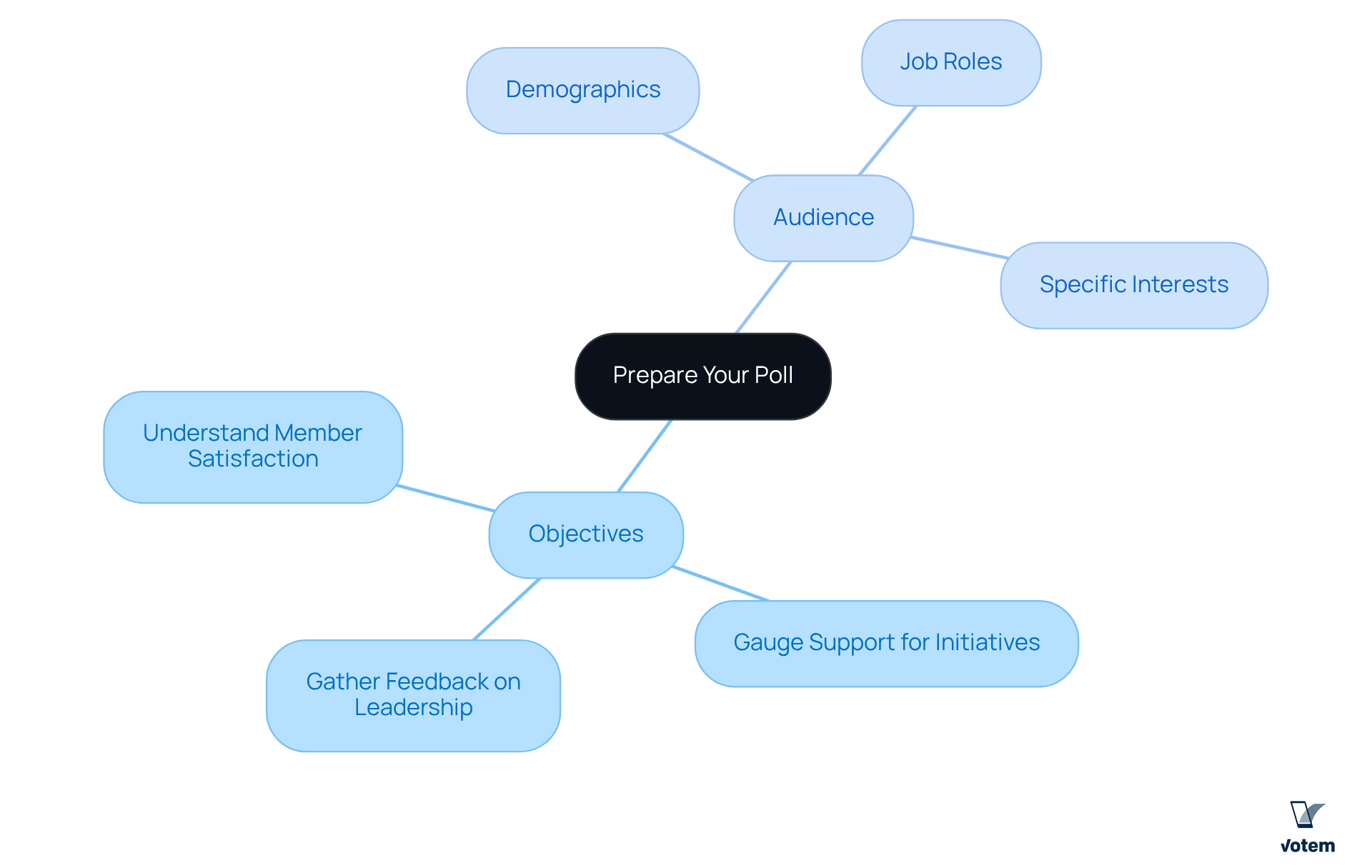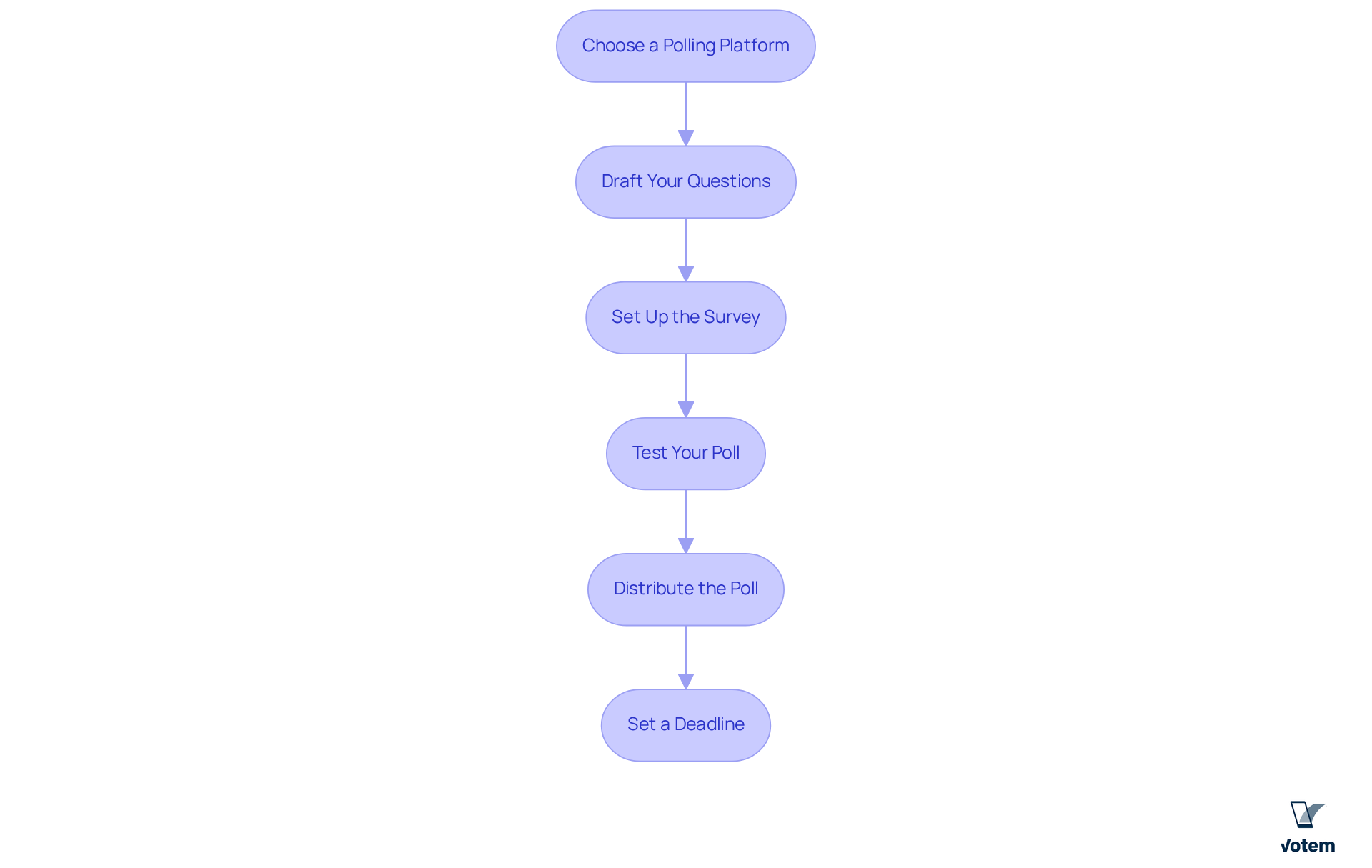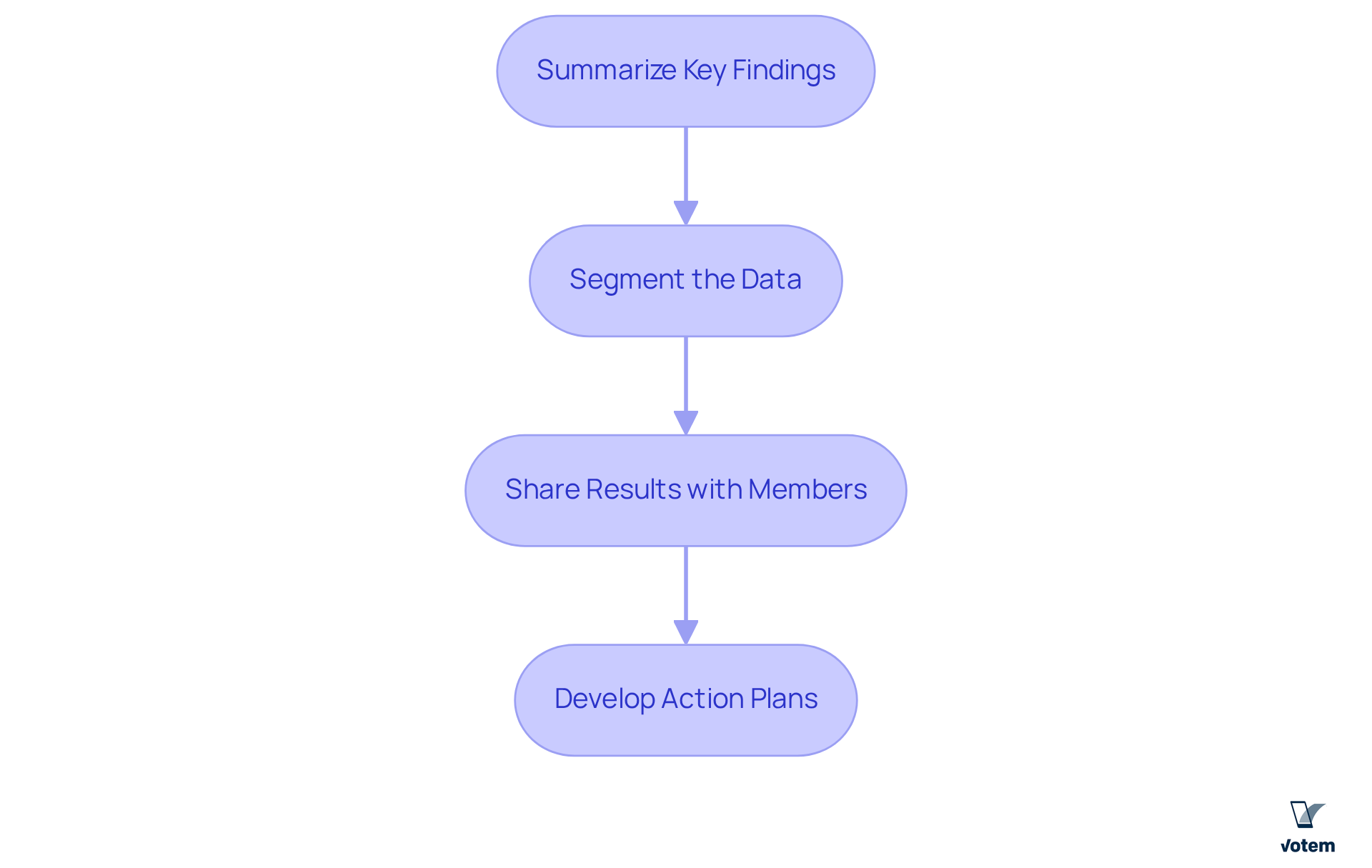Overview
The article titled “Send a Poll: A Step-by-Step Guide for Union Leaders” underscores the pivotal role of polls in union leadership. It provides comprehensive instructions on effectively creating and distributing polls, capturing the essence of member feedback, enhancing transparency, and fostering engagement. Notably, evidence demonstrates that strategic use of polls leads to improved participant involvement and heightened organizational trust. This guide is not just an informative piece; it serves as a call to action for union leaders to leverage polls as a tool for strengthening their organizations. By implementing these strategies, union leaders can significantly enhance their connection with members, ensuring their voices are heard and valued.
Introduction
Polls have emerged as a powerful mechanism for union leaders to engage their members and shape organizational decisions. By harnessing the collective voice of their constituents, leaders can gauge support for initiatives while fostering a culture of transparency and trust. However, the challenge lies in effectively designing and implementing these polls to ensure meaningful participation and actionable insights.
How can union leaders navigate this process to maximize engagement and drive positive change within their organizations? This question not only highlights the importance of polls but also sets the stage for exploring strategies that can enhance their effectiveness.
Understand the Importance of Polls for Union Leadership
Polls serve as an essential tool for organizational leaders, allowing them to send a poll that facilitates significant interaction with participants and gathers their perspectives on various matters. By providing a platform for individuals to express their opinions, surveys can send a poll to ensure that leadership decisions align with the collective interests of the group. This process empowers leaders to identify key concerns, assess support for initiatives, and promote transparency within the organization. Such democratic practices not only bolster trust among participants but also allow members to send a poll, cultivating a sense of belonging and active engagement.
Furthermore, surveys function as a strategic instrument in discussions, enabling leaders to send a poll to gain clearer insights into the workforce’s needs and drive positive change within the organization. Successful case studies underscore how effective surveying, including the ability to send a poll, has led to increased participant involvement and strengthened collective unity, highlighting the vital role of surveys in organizational decision-making. For instance, Gallup surveys reveal that public approval of labor organizations surged from 61% in 2017 to 70% in 2024, illustrating the growing support for collective engagement.
Moreover, studies indicate that regions employing robust surveying methods have witnessed significant improvements in participant engagement and trust, highlighting the importance of using surveys to send a poll in organizational leadership. By leveraging these insights, leaders can foster an environment that not only values participant input but also drives meaningful transformation.

Prepare Your Poll: Define Objectives and Audience
Before establishing a survey, union leaders must clearly define the objectives they wish to achieve. Are you aiming to understand member satisfaction, gauge support for a new initiative, or gather feedback on leadership performance?
Once these objectives are established, it is crucial to identify the target audience to send a poll. Consider factors such as demographics, job roles, and specific interests within the union. This comprehension will assist in formulating questions that resonate with individuals and promote involvement.
For instance, if the poll aims to assess interest in a new training program, ensure that the questions are relevant to the members who would benefit from such training.

Create and Send Your Poll: Step-by-Step Instructions
-
Choose a Polling Platform: Begin by selecting a user-friendly online polling tool that aligns with your requirements. Options such as Google Forms, SurveyMonkey, and the CastIron platform stand out, particularly for their focus on secure and compliant polling tailored for unions. The CastIron platform provides features like end-to-end encryption and real-time analytics, ensuring a secure voting process that can significantly enhance turnout. Testimonials highlight the organization’s success in managing large-scale voting events, demonstrating its capability to enhance voter participation and accessibility.
-
Draft Your Questions: Create clear and concise questions based on your objectives. Incorporate a variety of formats, including multiple-choice, rating scales, and open-ended questions, to capture a broad spectrum of feedback. Lindsey R., Senior Executive of the Space Coast Association of REALTORS®, emphasizes that user-friendly platforms enhance engagement, making it easier for members to participate. Votem’s innovative solutions have garnered praise for their ability to cater to diverse voter needs, including those of military voters and individuals with disabilities.
-
Set Up the Survey: Log into your chosen platform and initiate a new survey. Enter your questions and customize settings such as anonymity, response limits, and submission deadlines to suit your audience’s preferences. This customization is essential for ensuring that the poll meets the specific requirements of your union participants. Votem’s systems facilitate a smooth voting experience, featuring intuitive interfaces and robust support, which are crucial for maximizing participation.
-
Test Your Poll: Conduct a test run with a small group of trusted members to ensure clarity and functionality. Utilize their input to implement essential modifications, thereby improving the overall efficiency of your survey. Testing can help identify potential issues before the survey is distributed broadly. Votem’s commitment to quality assurance has been recognized in various successful elections, ensuring that the voting process is both reliable and user-friendly.
-
To distribute the poll, you can send a poll link through email, social media, or your union’s communication channels. Emphasize the importance of member input and consider sending a poll with incentives to boost participation rates. Poll Everywhere, for instance, has been trusted by 82% of Fortune 500 companies, showcasing the effectiveness of engaging tools in reaching a broad audience. The company’s proven track record, including managing 299,000 votes for the National Radio Hall of Fame, illustrates the effectiveness of their platform in driving engagement.
-
Set a Deadline: Clearly communicate the deadline for responses to instill a sense of urgency and ensure timely feedback. This approach not only encourages participation but also aids in gathering actionable insights. By establishing a clear deadline, you can ensure that feedback is collected promptly, allowing for swift decision-making. The organization’s capacity to achieve high turnout rates, as demonstrated in previous elections, underscores the significance of clear communication and deadlines in the voting process.

Analyze Poll Results: Make Informed Decisions
Once the voting has concluded, it is essential to examine the results thoroughly. Begin by reviewing the collected data, seeking trends and patterns that align with your objectives. Votem’s commitment to transparency and verifiability guarantees the integrity of the data you are analyzing. Utilize visual aids, such as charts and graphs, to present the findings in a clear and compelling manner. Consider the following steps:
-
Summarize Key Findings: Identify the most significant insights from the poll. What were the common themes in participant responses? Were there any surprising results that warrant further exploration?
-
Segment the Data: Break down the results by demographics or other relevant categories to gain insight into how different groups within the organization responded. This segmentation can highlight specific needs or concerns, ensuring that all voices are heard and considered.
-
To gather opinions effectively, send a poll. To ensure transparency, it is important to send a poll to share results with members. Distribute the findings to union participants, clarifying how their feedback will influence upcoming decisions and actions. Votem’s innovative online voting solutions, including end-to-end election services, empower you to communicate effectively and engage participants in the process.
-
Develop Action Plans: Based on the insights gained, create actionable plans to address participant concerns or implement new initiatives. Ensure that these plans are communicated back to the members, reinforcing their involvement in the decision-making process and fostering a sense of community and trust.

Conclusion
Polls serve not merely as a tool but as an essential mechanism for union leaders to engage with their members, gather opinions, and ensure that decisions embody the collective will of the organization. By effectively employing polling, union leaders can cultivate transparency and trust, ultimately fostering a more cohesive and empowered membership.
This guide has underscored the significance of defining clear objectives, understanding the target audience, and adhering to systematic steps for creating and analyzing polls. From selecting the appropriate polling platform to effectively communicating results, each phase is crucial in enhancing member participation and driving informed decision-making. The insights gleaned from polls can lead to actionable plans that address member concerns, thereby reinforcing the sense of community within the union.
In conclusion, embracing polling as a strategic tool can markedly enhance the effectiveness of union leadership. By prioritizing member input and leveraging data-driven insights, union leaders can nurture an environment of collaboration and responsiveness. This proactive approach not only fortifies trust but also empowers members to take an active role in shaping their union’s future. Now is the time for union leaders to harness the power of polls and transform member engagement into meaningful action.
Frequently Asked Questions
What is the primary purpose of polls for union leadership?
Polls serve as an essential tool for organizational leaders to gather participants’ perspectives, ensuring that leadership decisions align with the collective interests of the group.
How do polls promote transparency within organizations?
By allowing individuals to express their opinions, polls empower leaders to identify key concerns and assess support for initiatives, which fosters transparency and trust among participants.
What impact do polls have on participant engagement?
Polls cultivate a sense of belonging and active engagement among members, leading to increased participant involvement and strengthened collective unity.
Can you provide an example of the effectiveness of surveys in organizational decision-making?
Successful case studies show that effective surveying has led to increased participant involvement. For example, Gallup surveys indicated that public approval of labor organizations rose from 61% in 2017 to 70% in 2024, demonstrating growing support for collective engagement.
What benefits do regions experience by employing robust surveying methods?
Regions that utilize strong surveying methods have seen significant improvements in participant engagement and trust, highlighting the importance of surveys in organizational leadership.
How do polls help leaders drive positive change within organizations?
Surveys enable leaders to gain clearer insights into the workforce’s needs, which can help drive meaningful transformation within the organization.
List of Sources
- Understand the Importance of Polls for Union Leadership
- 16 million workers were unionized in 2024: Millions more want to join unions but couldn’t (https://epi.org/publication/millions-of-workers-millions-of-workers-want-to-join-unions-but-couldnt)
- Create and Send Your Poll: Step-by-Step Instructions
- Not for Profits, NGOs, societies, charities and clubs – ElectionBuddy (https://electionbuddy.com/customers/not-for-profits-ngos-societies-charities-clubs)
- Engage your audience | Poll Everywhere (https://polleverywhere.com)
- Analyze Poll Results: Make Informed Decisions
- US union organizing, and unions’ election win rate, is surging, NLRB says (https://reuters.com/legal/litigation/us-union-organizing-unions-election-win-rate-is-surging-nlrb-says-2024-07-17)
- Case Studies | RCLCO Real Estate Consulting (https://rclco2024.lvdev.net/resources/case_studies)

